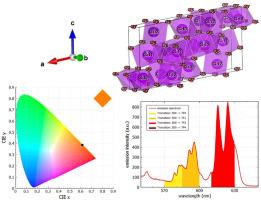Investigation of structural profiles and lattice dynamics in Gd2O3-Based multication phosphorescent materials: Studies on crystal field splitting and photoluminescence characteristics
IF 3.5
3区 化学
Q2 CHEMISTRY, INORGANIC & NUCLEAR
引用次数: 0
Abstract
Gd2O3:Eu3+: Li phosphors were synthesized via high-temperature solid-state reactions, revealing significant symmetry distortions and wavelength tuning to orange emissions upon lithium incorporation. Li+ ions introduced crystal field effects that favored electric dipole transitions. Rietveld refinement of X-ray diffractogram data (Li doping: 4 %–12 %) confirmed phase purity. Incorporating Li + ions into Eu3-doped Gd2O3 nanoparticles induced notable changes in lattice dynamics, evidenced by Raman mode evolution. Raman intensity increased up to 10 % Li doping and decreased beyond, indicating an optimal doping concentration for structural coherence. UV–Vis spectroscopy and Tauc plot analysis showed a red shift in the absorption edge and enhanced absorbance due to oxygen vacancies and interstitial defects. The optical bandgap narrowed from 5.71 eV (undoped) to 5.17–5.08 eV with Li doping, confirming defect-driven modulation of the electronic structure and improved energy transfer in the Eu3+-activated matrix. Photoluminescence spectra and CIE analysis revealed rare orange emissions from Eu3+. Judd–Ofelt (JO) theory was applied to assess the luminescent properties. JO parameters (Ω2 and Ω4), along with fluorescence lifetimes and radiative transition rates, validated the efficiency of the samples as orange emitters. Calculations showed Ω2 values were consistently greater than Ω4, indicating asymmetry in the local environment of the dopant, which enhances the relaxation of electric dipole selection rules. This asymmetry facilitates intense 5D0 → 7F2 transitions, accounting for the enhanced orange emission intensity. These findings suggest the samples as promising candidates for efficient orange-emitting phosphors.

基于gd2o3的多阳离子磷光材料的结构轮廓和晶格动力学研究:晶体场分裂和光致发光特性的研究
通过高温固相反应合成了Gd2O3:Eu3+: Li荧光粉,在加入锂后显示出明显的对称性畸变和橙色发光波长调谐。Li+离子引入了有利于电偶极子跃迁的晶体场效应。x射线衍射数据的Rietveld细化(Li掺杂:4% - 12%)证实了相纯度。将Li +离子加入到eu3掺杂的Gd2O3纳米颗粒中,可以引起晶格动力学的显著变化,这可以通过拉曼模式演化得到证明。当Li掺杂10%时,拉曼强度增加,超过10%则降低,表明结构相干性的最佳掺杂浓度。紫外-可见光谱和Tauc图分析表明,由于氧空位和间隙缺陷,吸收边红移和吸光度增强。Li掺杂后的光学带隙从5.71 eV(未掺杂)缩小到5.17-5.08 eV,证实了缺陷驱动的电子结构调制和Eu3+激活矩阵中能量转移的改善。光致发光光谱和CIE分析显示Eu3+发出罕见的橙色辐射。采用Judd-Ofelt (JO)理论评价了材料的发光性能。JO参数(Ω2和Ω4)以及荧光寿命和辐射跃迁率验证了样品作为橙色发射器的效率。计算表明Ω2值始终大于Ω4,表明掺杂剂局部环境的不对称性,增强了电偶极子选择规则的弛豫。这种不对称性促进了强烈的5D0→7F2跃迁,导致了橙色发射强度的增强。这些发现表明,这些样品是高效橙色发光荧光粉的有希望的候选者。
本文章由计算机程序翻译,如有差异,请以英文原文为准。
求助全文
约1分钟内获得全文
求助全文
来源期刊

Journal of Solid State Chemistry
化学-无机化学与核化学
CiteScore
6.00
自引率
9.10%
发文量
848
审稿时长
25 days
期刊介绍:
Covering major developments in the field of solid state chemistry and related areas such as ceramics and amorphous materials, the Journal of Solid State Chemistry features studies of chemical, structural, thermodynamic, electronic, magnetic, and optical properties and processes in solids.
 求助内容:
求助内容: 应助结果提醒方式:
应助结果提醒方式:


